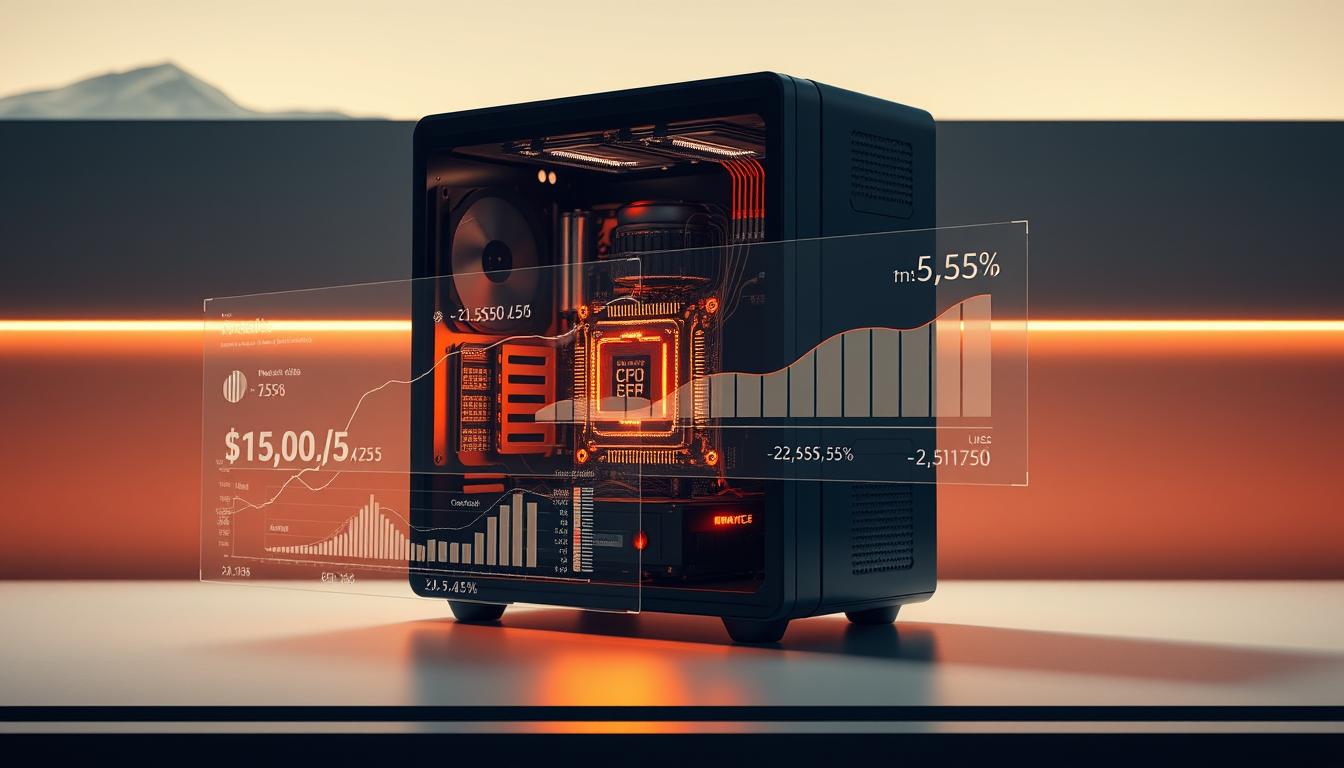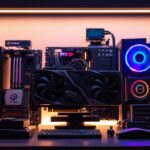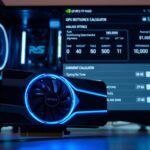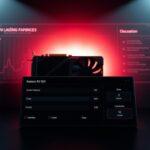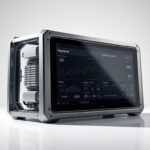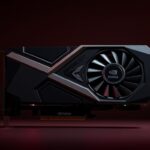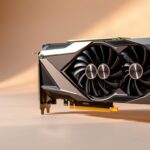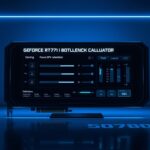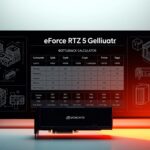Last Updated on July 16, 2025 by Gill
Are you wasting money on your computer because of common myths about PC performance? Many of us spend a lot on upgrades, but we don’t see the results we want.
Believing in myths about bottlenecks can lead to expensive mistakes. For example, thinking a single part is the problem without seeing the big picture can cause you to spend too much.
It’s important to know the truth about these myths to maximize your PC’s performance and save money. In this article, we’ll clear up common myths about bottlenecks. We’ll also share tips on how to get the most out of your system.
Understanding PC Bottlenecks in 2025
In the world of PC hardware, knowing about bottlenecks is key. A bottleneck happens when one part of the system slows down the whole thing. This makes things run slower and less efficiently.
What Actually Constitutes a Performance Bottleneck
A bottleneck occurs when a part like the CPU, GPU, or RAM holds back the system. For example, a top-notch GPU won’t work well with a slow CPU. This is because the CPU can’t keep up with the GPU’s speed.
How System Limitations Impact Overall Experience
System limits can really affect how well you use your PC, whether for gaming or work. A bottleneck can cause lower frame rates, more lag, and slower speeds. This all adds up to a less-than-ideal user experience.
Gaming vs. Productivity Bottlenecks
Gaming bottlenecks usually involve the GPU and CPU not working together well. On the other hand, productivity bottlenecks might be about storage or RAM. Slow data access or not enough memory can slow things down.
| Bottleneck Type | Causes | Effects |
|---|---|---|
| Gaming Bottleneck | GPU-CPU imbalance, outdated drivers | Reduced frame rates, increased lag |
| Productivity Bottleneck | Insufficient RAM, slow storage | Slower processing times, decreased productivity |
It’s important to know the difference between gaming and productivity bottlenecks. This knowledge helps in PC Performance Optimization and Improve PC Speed. By tackling these bottlenecks, you can make your system run better and avoid common problems.
Why Bottleneck Misconceptions Are Expensive Mistakes
Knowing the truth about bottlenecks can save you money. Many think upgrading their PC will automatically make it faster. But, this isn’t always true. Misconceptions about PC bottlenecks can lead to costly and unnecessary upgrades.
The cost of these mistakes is high. Users often spend money on upgrades that don’t fix the real problem. It’s important to understand the performance-to-cost ratio.
The Financial Impact of Unnecessary Upgrades
Upgrading without knowing the bottleneck can waste a lot of money. For example, getting a top-notch GPU won’t help much if the CPU is slow. This is because the CPU is the main problem.
The Performance-to-Cost Ratio Explained
The performance-to-cost ratio is key for evaluating upgrades. It shows if a component upgrade is worth the cost. By looking at this ratio, users can choose upgrades wisely. This way, they can boost their PC’s efficiency without spending too much.
Long-term Cost Analysis of Impulsive Upgrades
Impulsive upgrades can lead to a cycle of spending. A long-term look shows these decisions can cost a lot more. On the other hand, making smart upgrades based on knowing the bottlenecks can save money. It also makes your PC run better.
Myth #1: “You Always Need the Latest CPU to Avoid Bottlenecks”

Many think the newest CPU is a must to avoid bottlenecks. But, this idea can lead to spending too much. To maximize PC performance, knowing the CPU’s role is key. Additionally, it’s important to consider other factors that contribute to overall system efficiency, such as RAM and storage speed. Incorporating cpu temperature monitoring methods can also help ensure optimal performance by preventing overheating that could hinder processing capabilities. Prioritizing a balanced approach rather than constantly upgrading components often yields better long-term results.
The Truth About CPU Generations and Diminishing Returns
New CPU generations offer better architecture and power use. Yet, the law of diminishing returns applies. Each new generation doesn’t always double the performance of the last. For most, the difference between the latest and older CPUs is small.
When an Older CPU Is Actually Sufficient
Older CPUs are fine for tasks like web browsing and office work. They’re also good for some gaming. The important thing is to match your hardware to your needs, not just upgrade to the newest CPU.
Gaming Performance Comparisons Across Generations
Some say you need the latest CPU for gaming. But, the truth is, the GPU makes a bigger difference. Here’s a comparison: While a powerful CPU can improve performance in some scenarios, a high-quality GPU is essential for rendering graphics in modern games. For those looking to build a system without breaking the bank, keep an eye out for budget gaming pc recommendations 2025, as advancements in technology may allow for more affordable options that still deliver impressive performance. Investing in a good GPU can provide a significant boost to your gaming experience, making it a priority for any serious gamer.
| CPU Model | Generation | Average FPS in Game X | Average FPS in Game Y |
|---|---|---|---|
| Intel Core i9-11900K | 11th Gen | 140 | 120 |
| Intel Core i9-12900K | 12th Gen | 145 | 125 |
| AMD Ryzen 9 5900X | Zen 3 | 138 | 118 |
| AMD Ryzen 9 7950X | Zen 4 | 142 | 122 |
This table shows that newer CPUs don’t always mean better gaming performance.
Productivity Workload Analysis with Different CPUs
For tasks like video editing, the CPU is more important. But, the difference between generations is often small. It’s more about PCIe lanes and RAM speed.
To improve PC speed, balance your system’s parts. Don’t just focus on the CPU. Knowing your needs and the limits of new CPU generations helps make better upgrade choices.
Myth #2: “GPU Bottlenecks Can Be Fixed by Simply Buying a More Powerful Card”
GPU bottlenecks are complex. Just buying a more powerful graphics card doesn’t fix everything. The performance of a GPU depends on many system components. Additionally, understanding how to balance CPU and GPU workloads is crucial for maximizing performance. Employing various gpu performance optimization techniques can help alleviate bottlenecks caused by inefficient resource allocation. Ultimately, a well-rounded approach that considers the entire system architecture will yield the best results. Factors such as CPU speed, memory bandwidth, and even storage type can significantly impact overall performance. Often, gaming performance issues revealed during testing can trace back to these overlooked components rather than the GPU alone. Therefore, a holistic approach to system upgrades is essential for optimizing gaming experiences.
The Complex Relationship Between GPUs and Other Components
A GPU doesn’t work alone. Its speed is affected by the CPU, RAM, and storage. For example, a top GPU can be slowed down by a weak CPU.
Resolution and Game Settings: The Real Performance Factors
Resolution and game settings really matter for GPU performance. Higher resolutions like 4K need more from the GPU. So do detailed game settings.
1080p vs. 1440p vs. 4K Considerations
At lower resolutions like 1080p, a mid-range GPU can handle demanding games. But, at 1440p or 4K, the GPU’s power is more important. It’s key to match the GPU with the monitor’s resolution and refresh rate.
When a Mid-Range GPU Outperforms High-End Models
In some cases, a mid-range GPU beats a high-end model. This happens when the high-end GPU isn’t optimized for certain games. Also, if other system parts aren’t strong, the high-end GPU won’t perform its best.
Understanding these points is vital for PC Performance Optimization. By looking at the whole system, not just the GPU, users can make better upgrade choices. This helps avoid Common PC Bottlenecks. By debunking PC Bottleneck Myths, users can save money and have a more balanced PC.
Myth #3: “More RAM Always Means Better Performance”
Many think adding more RAM makes their PC faster. But, this isn’t always true. RAM is key for system efficiency, but more of it doesn’t always mean a quicker PC.
The Diminishing Returns of Excessive RAM Capacity
Having enough RAM is vital for smooth multitasking. Yet, adding too much RAM doesn’t always boost performance. For everyday tasks and gaming, 16GB to 32GB of RAM is usually enough.
RAM Speed vs. Capacity: What Actually Matters for Your Workload
Users often get confused between RAM speed and capacity. RAM capacity is about how much data it can hold. RAM speed is how fast it accesses that data. For most tasks, a mix of both is best. For example, 16GB of fast RAM is better than 32GB of slow RAM for tasks that need quick access.
DDR4 vs. DDR5: Worth the Upgrade in 2025?
Choosing between DDR4 and DDR5 RAM depends on your system and needs. DDR5 is faster and might offer better performance. But, it needs a compatible motherboard. If you have DDR4, upgrading to DDR5 might not be worth it unless you’re upgrading your whole system.
Optimal RAM Configurations for Different Use Cases
Different tasks need different RAM setups. For general use and gaming, 16GB to 32GB of DDR4 or DDR5 RAM at 3200MHz is best. For tasks like video editing or 3D modeling, more high-speed RAM is better. Here are some top picks: When considering future-proofing your setup, it’s wise to aim for higher capacities and speeds, especially if you’re working with resource-intensive applications. In the upcoming years, as new software demands grow, the RAM bottleneck explained in 2025 will become increasingly relevant for performance optimization. Upgrading to faster RAM can directly impact load times and multitasking efficiency, making it a crucial factor in your system’s overall performance.
- For general use: 16GB DDR4 RAM
- For gaming: 32GB DDR4 or DDR5 RAM
- For video editing: 32GB or more of high-speed DDR5 RAM
To Improve PC Speed and Boost PC Efficiency, consider these factors for RAM upgrades. Knowing how RAM affects performance helps avoid unnecessary costs. This follows valuable PC Upgrade Tips.
Myth #4: “Storage Doesn’t Affect Gaming Performance”
The myth that storage doesn’t affect gaming performance is wrong. Storage technology greatly impacts load times and gameplay. To maximize PC performance, knowing how different storage types affect gaming is key.
The Impact of SSDs vs. HDDs on Load Times and Gameplay
SSDs have changed gaming by cutting down load times a lot. HDDs can store lots of data but are slower. This slows down PC performance optimization.
NVMe vs. SATA: When the Difference Actually Matters
The NVMe vs. SATA SSD debate is important. NVMe SSDs are faster than SATA SSDs. They’re best for games needing quick data access.
For gamers, NVMe SSDs make games load faster and systems more responsive.
Real-world Performance Benchmarks
Tests show NVMe SSDs beat SATA SSDs in gaming. Games that need quick asset loading benefit from NVMe’s high bandwidth.
DirectStorage and Future Gaming Storage Requirements
Technologies like DirectStorage highlight storage’s role in gaming. DirectStorage lets the GPU access storage directly, speeding up game loading. It will soon be a must in gaming PCs, making NVMe SSDs a top choice for performance.
In summary, storage tech is essential for gaming. Choosing the right storage can greatly improve gaming. It’s a key part of PC performance optimization.
Myth #5: “Bottlenecks Are Always Hardware-Related”
Many think bottlenecks are only about hardware. But, software is also key to system performance. Often, bottlenecks come from software problems.
Software Bottlenecks: The Hidden Performance Killers
Software bottlenecks can come from bad coding, heavy programs, and background tasks. For example, a slow game can make your fast computer slow. To improve PC speed, finding and fixing these software issues is vital.
Operating System Optimization Techniques
Improving your operating system is important for boosting PC efficiency. You can do this by tweaking settings, updating drivers, and controlling background tasks. This makes your system run better.
Background Processes and Their Impact
Background tasks can slow down your system a lot. They use up CPU, RAM, and disk space. To fix this, use task managers to stop unnecessary tasks. This freeing up resources for more critical tasks.
Driver Updates and Their Critical Role in System Performance
Old drivers can make your system unstable and slow. Keeping drivers up to date helps hardware work well with your OS. This simple step can improve PC speed and make your system more reliable.
Understanding software bottlenecks helps you make better choices about upgrades and optimization. This approach can save money and make your computer work better.
5 PC Bottleneck Myths That Are Costing You Money: The Real Cost Analysis
Understanding the true cost of PC bottleneck myths can save you hundreds of dollars. Many PC enthusiasts make costly mistakes due to misconceptions about bottlenecks. This leads to unnecessary upgrades.
Calculating the Price of Unnecessary Upgrades
Believing in common PC bottleneck myths can cost a lot. Upgrading to the latest CPU or GPU without checking other parts is a waste. It’s important to know what your system really needs.
Cost-Effective Alternatives to Expensive Hardware
Instead of buying the latest hardware, look for cost-effective alternatives. Simple tweaks like optimizing your GPU settings or adjusting game resolutions can boost performance. You won’t need to spend a lot on upgrades.
Budget-Friendly Optimizations with Maximum Impact
To maximize PC performance without spending a lot, try these PC upgrade tips:
- Upgrade your RAM to the right amount for your tasks.
- Switch to an NVMe SSD if you’re using a traditional hard drive.
- Adjust your game settings to find a balance between performance and visuals.
By using these tips, you can save money on PC bottleneck cost. You’ll get a more balanced system without breaking the bank.
How to Accurately Identify Your System’s True Bottlenecks
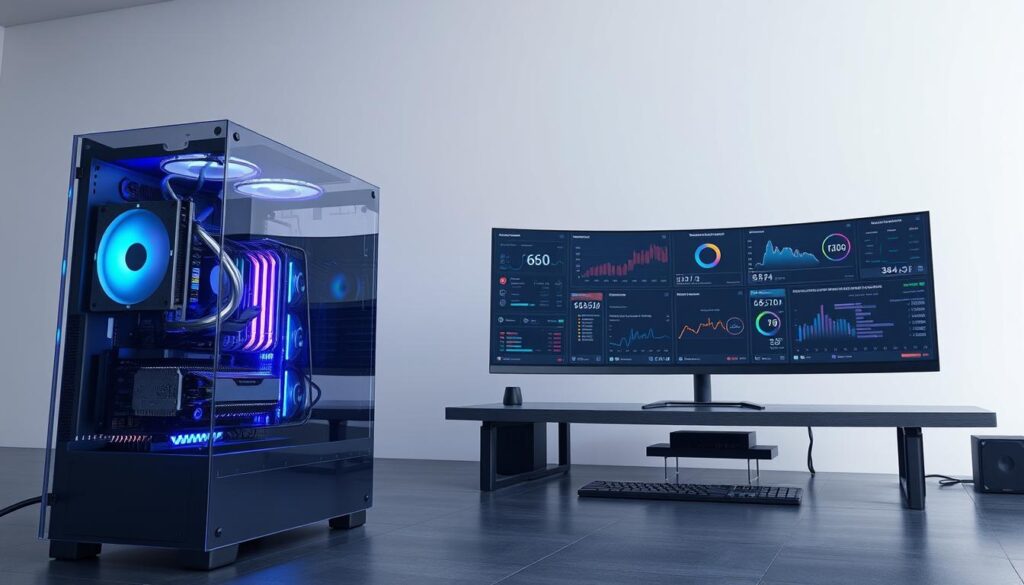
Figuring out where your system slows down is key to making it better. To improve PC speed, you must know where the problems are.
Essential Diagnostic Tools and Techniques
To find bottlenecks, you’ll need tools that watch how your system performs. Tools like CPU-Z, GPU-Z, and memory benchmarking software give you clues about your parts’ performance.
For example, watching CPU and GPU use during tough tasks shows if they’re too busy or not busy enough.
Interpreting Performance Metrics Correctly
It’s important to understand performance metrics for PC performance optimization. You must know how to read data on CPU, GPU, and memory use.
CPU, GPU, and Memory Utilization Explained
- CPU Utilization: High CPU use during tasks like video editing or gaming means a bottleneck.
- GPU Utilization: High GPU use during graphics-heavy tasks shows the GPU is a problem.
- Memory Utilization: Not enough RAM causes big slowdowns, mainly when doing many things at once.
Creating a Targeted Upgrade Plan Based on Real Data
After finding the bottleneck, you can make a plan to fix it. This way, you’re tackling the common PC bottlenecks that slow you down. Implementing upgrades or optimizations based on your findings can significantly enhance your system’s efficiency. Researching how to resolve PC performance issues will provide you with various strategies, from hardware upgrades to software solutions. Regular maintenance and monitoring can also help prevent future bottlenecks, ensuring a smoother computing experience.
By focusing on the weakest part, you make smart choices that boost your system’s speed a lot.
Conclusion: Building a Balanced System Without Breaking the Bank
Knowing the 5 PC Bottleneck Myths is key to a cost-effective PC. These myths can lead to unnecessary spending. By understanding them, you can upgrade wisely and save money, making your PC perform better without costing too much.
Identifying true bottlenecks is essential for a high-performing system. This lets you make smart choices that boost performance while keeping costs low. You’ll use your budget better, making sure your PC can handle tough tasks without spending too much.
With the knowledge from this article, you can build a PC that fits your needs without overspending. This balanced way of building PCs ensures you get the best from your hardware. You’ll enjoy a better computing experience without breaking the bank.
- RTX 3070 Bottleneck Calculator: Optimize Your Setup - September 27, 2025
- Optimize Your RTX 3060 Ti: Use Our Bottleneck Calculator - September 26, 2025
- GeForce RTX 5060 Bottleneck Calculator – Find Your GPU’s Limits - September 25, 2025

